Have you ever wondered how rocket ships are able to take people to the moon? In this activity, we will learn about how a real rocket works by building our own model rocketship.
What is a model? A model is anything that can be used to represent something else. In this case, it’s a miniature figure used to represent something much bigger. Scientists use models all the time to make predictions when testing the real thing isn’t safe, or isn’t possible. Think of crash test dummies, which act as models of people in car airbag tests, or computer models of tropical storms that are used to predict hurricanes. Toy cars can also be thought of as models.
In our case, we can’t build the real thing. Rockets are too big, too expensive, and too dangerous to build in your kitchen at home. Instead, we’ll build a model of a rocket ship- a small, inexpensive, and safe representation of the real thing that you can hold in your hands!
You can build your rocket ship out of almost anything. Plastic bottles and paper towel tubes work well since they are already shaped somewhat like a rocket, but the sky’s the limit!
Suggested Materials:
For this project you’ll need: 1 paper towel tube, 4 toilet paper tubes, aluminum foil, tape or glue, 4 empty spools, candy wrappers, paper, markers/crayons/colored pencils/pens, scissors (ask a grown up to help!)
What to do:
1. Cut each of the toilet paper rolls to remove a ¼ section of the tube. Put these smaller sections aside until step 3.
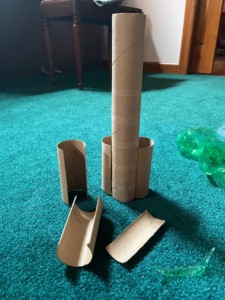
Step 1 – Prepare your materials!
2. Put each of the cut tubes at the base of the paper towel tube. This will form the base of the rocket. In this design, the ¾ tubes represent the boosters for the rocket, pieces which fall away after they exhaust their fuel as the rocket advances through the atmosphere into space.
3. Use the ¼ tube pieces to act as struts, connecting the boosters to the main rocket. This will create support for the boosters so that they don’t fall off before they are meant to, while making the rocket more aerodynamic (that means it moves well through the air).
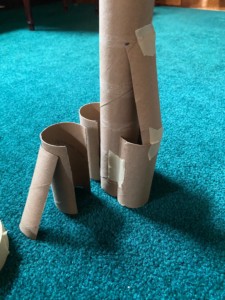
Step 3a – Connecting the boosters.
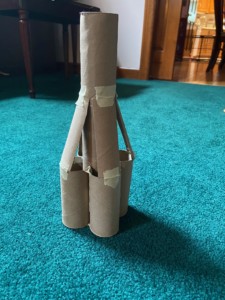
Step 3b – More boosters..
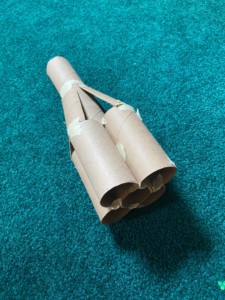
Step 3c – Boosters check!
Aerodynamic- think of the difference between trying to throw a piece of paper and a paper airplane. Both are the same weight and the same material, but the shape makes the paper airplane ‘fly’!
4. OPTIONAL: Cover the boosters in aluminum foil (or paper) to decorate them! You can also decorate them more later by coloring with markers, crayons, colored pencils, or pens.
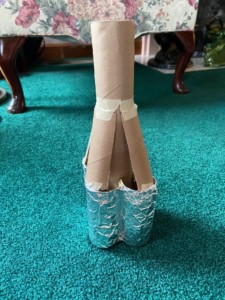
Step 4 – Optional Foil
5. Cover the area over the struts. We recommend doing this with a piece of paper so that it’s easier to draw a door on, but aluminum foil can also work! The key to this step is making sure that the covering is slightly curved so that when pulled around the rocket, it makes a narrow circle at the top and a wider circle towards the base. The shape should be like a banana with both of the ends cut off.
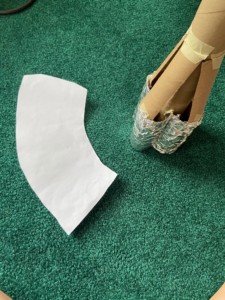
Step 5a – We recommend using paper.
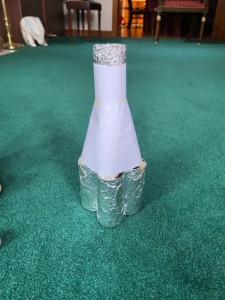
Step 5b – Paper in place!
6. Now’s your chance to get creative! You can cover the rest of the rocket with foil, candy wrappers, or paper. To make the nose of the rocket, use aluminum foil to create a cone shape.The cone should just sit on the top of the rocket- attaching it is optional! If you leave it unattached or only attach it on one side, you can use it to put things inside your rocket. For instance, you could put a small action figure inside if you wanted to give your rocketship some astronauts!
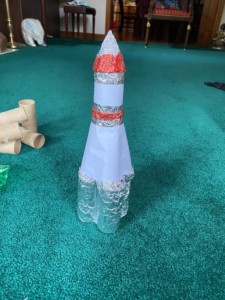
Step 6 – Get creative!
7. If you have old spools from thread, you can make them into ‘boosters’ for your rocket! By using some red foil from a candy wrapper, you can even make it look like it’s fire-y and ready to take off!
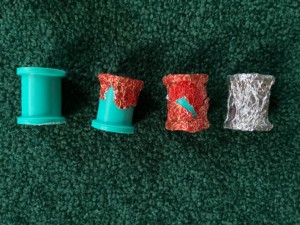
Step 7 – Fiery spools!
8. Finish customizing the look of your rocket using pens/pencils/markers, and PREPARE FOR LAUNCH! If you want to go the extra mile, you can do a countdown just like for a real rocket ship.
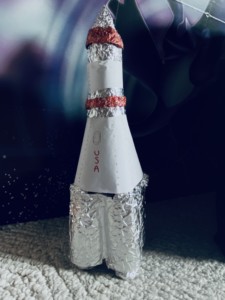
Rocket ship ready!
Where will your rocket ship go? What will you discover? Tell us in the comments!

Where will your rocket ship go?
About the Author: Callie Smith is an intern in the WonderLab Museum Experience Department and a graduate student at Indiana Univerity’s O’Neill School of Public and Environmental Affairs. Her passion for science started at a young age, and as an educator, she loves to encourage that same sense of curiosity in kids. Callie loves all kinds of animals (especially birds!) and likes to spend time drawing, gardening, and playing video games.



Leave A Comment